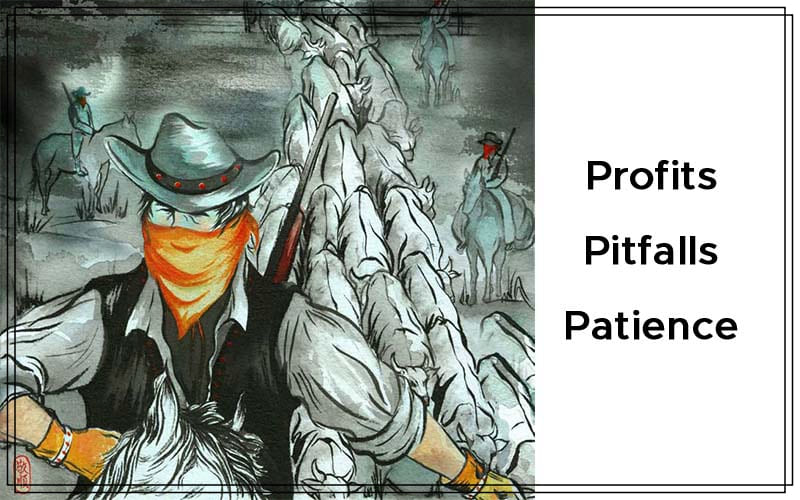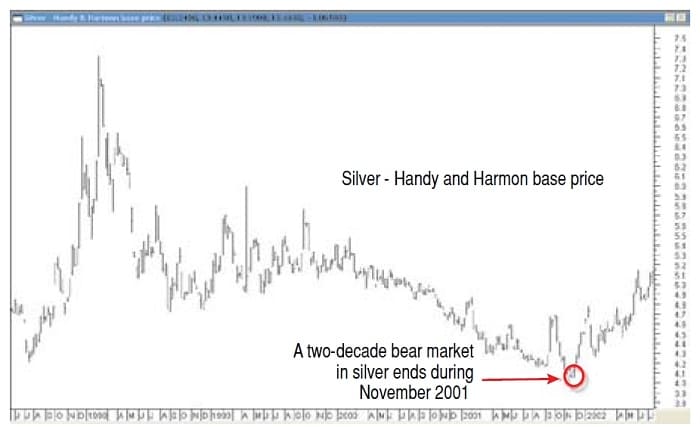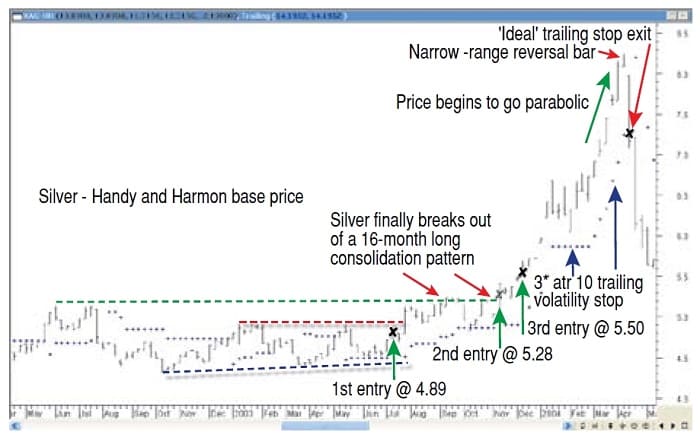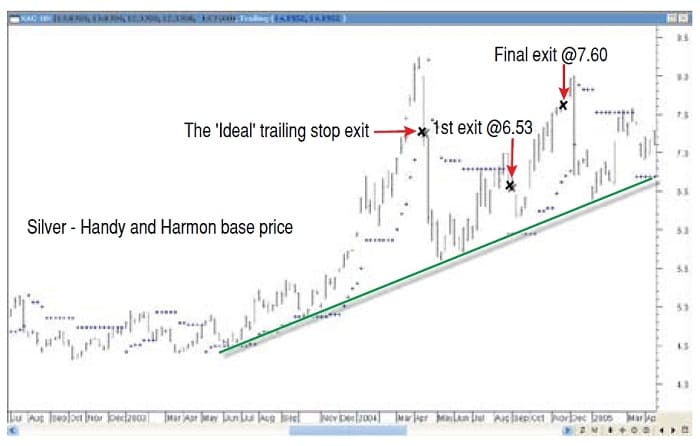Articles
Profits, Pitfalls, Patience By Donald W. Pendergast

Plan your trade, trade your plan. Here’s what can happen when a trader plunges into a position without following a trading blueprint. If God really watches over children and fools, then I must have been among that special group of foolish, childlike traders who were “miraculously” bailed out of trades that tragically went wrong. Here’s what happened when a fundamentally sound, long-term position trade gathered steam, peaked, and then crashed before finally recovering, eventually regaining most of the profits, despite taking twice as long as planned to realize them.
The Trade Setup of a lifetime
In autumn 2001, I received an advertisement that extolled the value of silver, a commodity that was languishing in the cellar of a 20-year-old bear market, but which was now also giving evidence that a major bottom had formed (Figure 1). At $4.50 an ounce, it was hard to reconcile the advertisement’s ultrabullish prognostications with the dirtcheap asking price for the beaten-down commodity.

FIGURE 1: A MAJOR BOTTOM OF SILVER. In November 2001, silver made a low at $4.50. It then began to trace out a series of higher highs and higher lows.
I thought nothing more about it until May 2003. At that point, after making the dead low in November 2001, silver had already begun to trace out a series of higher highs and higher lows and was trading at $4.80. Once again, I received the same ultrabullish sales pitch to buy silver. After doing some research, I decided that the downside risk of approximately $1 an ounce was well within my risk tolerance. The global supply/demand situation for the metal was bullish, and the world was on the verge of a new commodity bull market. Of course, the ad copy’s suggestion that silver could eventually top $50 put a potent dose of confidence behind my decision to buy.
Scaling In
I began to accumulate silver in early July 2003 (Figure 2), paying $4.89 for my initial position of real metal (no futures contracts were used in this trade). Since I decided to scale in as price moved (hopefully) higher, I waited for a few months, jumping in again in early November at about $5.28 an ounce. I still held a mental stop at $4, just in case there was some unexpected turbulence. By then the series of higher highs/higher lows was well established, and my heart raced in anticipation of a sudden surge in price.

FIGURE 2: SCALING IN. A powerful trend move ensues after a successful consolidation pattern breakout.
I didn’t have to wait long. The weekly price action of November 14, 2003, was the setup signal I’d been waiting for, and after a break above that week’s high, I acquired my final position at $5.50 an ounce in early December. This signal occurred after silver finally broke out of a well-formed weekly consolidation pattern, thus lending even more credence to the possibility of a major trend-following move.
Suggested Books and Courses About Investment
Still not sure about where to keep my stop, I alternated between the 2001 low of $4.06 and the more recent low of $4.40. The battle between fear and greed was strong, and that made it hard to stay with a firm stop. By mid-December, silver had begun to settle into a strong uptrend, so I winged it on the stop, figuring I’d know what to do if there were a major reversal. Famous last words. Meanwhile, visions of silver bars with $50 price tags were dancing through my head, no doubt fueled by my constant diet of bullish-only precious metals commentary on the Internet.
Silver Reversal And A Parabolic Move
I got my chance to sit through a minor correction in silver from mid-January until early February 2004. By this time silver had peaked at $6.69, so I was up about 28%, based on my average entry price of $5.23. I decided to bring my mental stop up to $5 and see what happened. After all, I didn’t want to miss out on a move to that possible $50 level, deciding to give the position some breathing room. Silver reversed at $6.06, well above my mental stop, never looking back until it topped out at $8.235 in early April. As price cleared $7.50, I saw that the weekly chart was going vertical, and I began to get nervous. I’d seen parabolic chart patterns like this before, and my gut was telling me to take partial profits and/or trail a much closer stop. But I was still fixated on that mythical $50 level. I decided to watch the chart for another week to see what would happen.
Silver Sells
One week somehow morphed into three. I was up 57% on the position as of Friday, April 8, 2004 (Figure 3). I saw the pitiful, narrow-range weekly reversal bar on the chart, and again, my gut was screaming, “Get out now! This thing’s going to sell off, and hard!” That pipe dream of a $50 level for silver won out. The following week the real fun began; futures traders began dumping long positions en masse, and by the weekend, price had plunged by 14%. The bearish weekly bar on super high volume was a clear indication that silver’s uptrend had reversed, and taking all of the position off was the only sane course of action. See Figure 4 for my trading results.

FIGURE 3: TIME TO EXIT. A reversal off the long-term uptrend line allows an undisciplined trader to ultimately exit with a profit.

FIGURE 4: SUMMARY OF RESULTS. While the final percentage returns are close, a disciplined trader would have enjoyed twice the average monthly return of the undisciplined trader. “Max PV DD%” is short for “Maximum peak to valley drawdown %.”
Yet again, thoughts of that $50 level kept me in, all the way down to the major low of $5.60 in mid-May 2004. Most of my 57% in paper profits vanished, and I was dumbstruck. This was supposed to be the bull market of the new millennium, wasn’t it? What the heck was going on? I felt like a cattle rancher whose prized herd had been rustled in the dead of night, and even worse, I was the one who had left the gate open.
No Apologies
After realizing that the silver gurus I’d been so faithfully following weren’t about to apologize for my lost profits, I decided to take responsibility for my trading actions. I acknowledged I needed a set of trading rules, a logical initial and trailing stop, and a proper size for each position, regardless of what any advisor or newsletter writer thought. I knew that fundamental analysis was important, but I decided to use only technical methods to size, enter, and exit every trade. A wonderful quote attributed to Paul Tudor Jones inspired me to change my behavior: “Lose your opinion instead of your money.” That quote cut right through all of the “buy, hold, & hope” illusions causing me to manage the trade irrationally. I realized that I could simply trade the individual moves in silver, taking rational profits along the way, no matter if it was heading for $5 or $50. Doing so would allow me to be profitable, even if the claims of $50 silver never materialized.
Drawing The Line
It was a painful lesson. I figured there would be at least a partial retracement, a five-week selloff, so I planned to get out on a move back above $6.50–6.70. This time, I made sure my fixed stop was just below the $5.60 low and also decided to book a decent profit if it materialized. Mercifully, the long-term trendline (the green line on Figure 3) provided solid support, and by late June 2004, silver’s uptrend appeared intact. In August 2004, I decided to sell 40% of the position at $6.53, fearing another selloff. I let the rest ride with a trend-line stop, deciding to exit all of my remaining position on a weekly close below it. That way, I guaranteed myself a profit, no matter what happened.
While I was still disappointed with the massive loss of initial potential profits, it was a relief to be spared from further trade management anxiety by following a basic set of exit rules. By that time, I was immune to any outside opinions about the silver market; I was focused on the chart alone. My confidence in my trading ability was growing, and I liked that feeling — I was a winner because I was following my plan.
Redemption and Final Exit
Silver ultimately made an attempt on the $8.24 high in early December 2004; I bailed out on the remaining 60% of the position at $7.60 in mid-November, with my stop-loss at $6.25. In the end, I made about 37% on the trade over the course of 17-plus months. Had I run a simple 3 * Atr 10 weekly trailing stop on the original move to $8.24, I would have exited the entire position at $7.25, for a profit of 39% in nine and a half months. Trading with a plan, one with a nonnegotiable exit in this case, would have been superior to “seat of the pants” trading, clearly.
If you don’t trade with a well-thoughtout plan, sooner or later the market’s going to come for you.
Path To Success
Fear and greed will play with your mind, causing you to make the worst possible decisions during periods of stress or crisis, and unless you set up a firm, irrevocable plan of action beforehand, you will be wiped out by the markets. Every trader must have a trading plan that deals with every aspect of his/her interaction with a given market. Craft a solid, nonnegotiable, stress-tested trading plan before you venture into the markets, and you will have a much greater chance of enjoying long-term trading and investing success. If you don’t trade with a well-thoughtout plan, sooner or later the market’s going to come for you. Your favorite trading guru isn’t going to shed any tears for you, either.
Donald W. Pendergast Jr. has been trading and investing since 1979. He may be reached via his website at www. chartw59.com.
